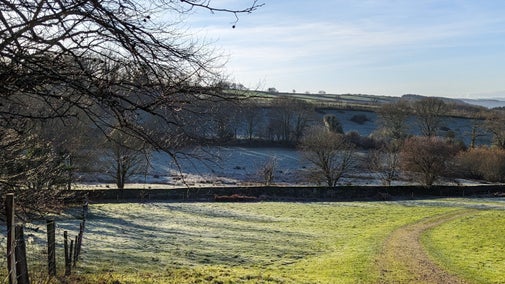
Donate
Everyone needs nature, now more than ever. Donate today and you could help people and nature to thrive at the places we care for.

Our work on the upkeep and conservation of Buckland Abbey has included everything from building repairs to woodland management, and we occasionally uncover some surprises that shed light on the lives of previous occupants.
Buckland was founded in 1278 as one of the last of the Cistercian monasteries to be built in medieval England and Wales. During the dissolution of the monasteries 250 years later, many of the Abbey’s buildings were destroyed.
Although fragments of the original building survive, it has undergone many modifications and phases of refurbishment over the years.
In late 2019, a £54,000 project began to repair Buckland Abbey’s Grade I listed Kitchen Garden wall, as the uneven ground levels of the slope on which it was built had caused it to lean significantly. During the course of this work, the area around the old wall was investigated by Trust archaeologist Jim Parry and his team.
As he painstakingly excavated the foundations, Jim uncovered stone steps that may once have been trodden by the Cistercian monks, and made other discoveries that provided new evidence of the site’s medieval history.
A new archaeological find is always exciting, and this recent discovery has uncovered tantalising new evidence of buildings probably relating to the 16th-century monastery, its demolition after Henry VIII's dissolution, and redevelopment as a home for famous seafarers such as Sir Francis Drake.
Jim and his team found that the existing Kitchen Garden wall contains around 36cm of brickwork belonging to a medieval building on the site. Although the two ends of the wall have been rebuilt, the central section, including a low arched opening believed to relate to a watercourse that once ran through the garden, appears to be original.
Also discovered in the foundations were a set of steps associated with a blocked doorway still visible on the downslope side of the existing wall. The material used to infill the steps contained a 16th-century tripod pipkin or skillet, suggesting that it was part of the medieval monastic complex demolished during the reign of Henry VIII.
The presence of a pair of garderobe chutes, associated with toilets, which would have been within a projecting turret, suggest that the structure was part of a two-storey range of lodgings roughly parallel to the Tower.
You can see the steps as you visit the Kitchen Garden, on the right hand side just beyond the seating area.

Everyone needs nature, now more than ever. Donate today and you could help people and nature to thrive at the places we care for.
Discover Buckland's ancient woodland on one of three colour coded routes. With abundant wildlife and far reaching views, it's a peaceful and fascinating place to enjoy.

Discover a wealth of history at Buckland Abbey, from its time as a medieval farming monastery to the famous Tudor explorers who called it home.

Explore the abbey which is part museum, part house, and filled with treasures. Step inside the medieval Great Barn: a tithe barn unchanged since it was built centuries ago.

We believe that nature, beauty and history are for everyone. That’s why we’re supporting wildlife, protecting historic sites and more. Find out about our work.

From beautiful blooms to bountiful harvests, the gardens at Buckland Abbey are full of colour and seasonal interest. Soak up the history of this special place as you admire the planting, or simply enjoy the peace and tranquillity as you sit a while on one of the benches.
